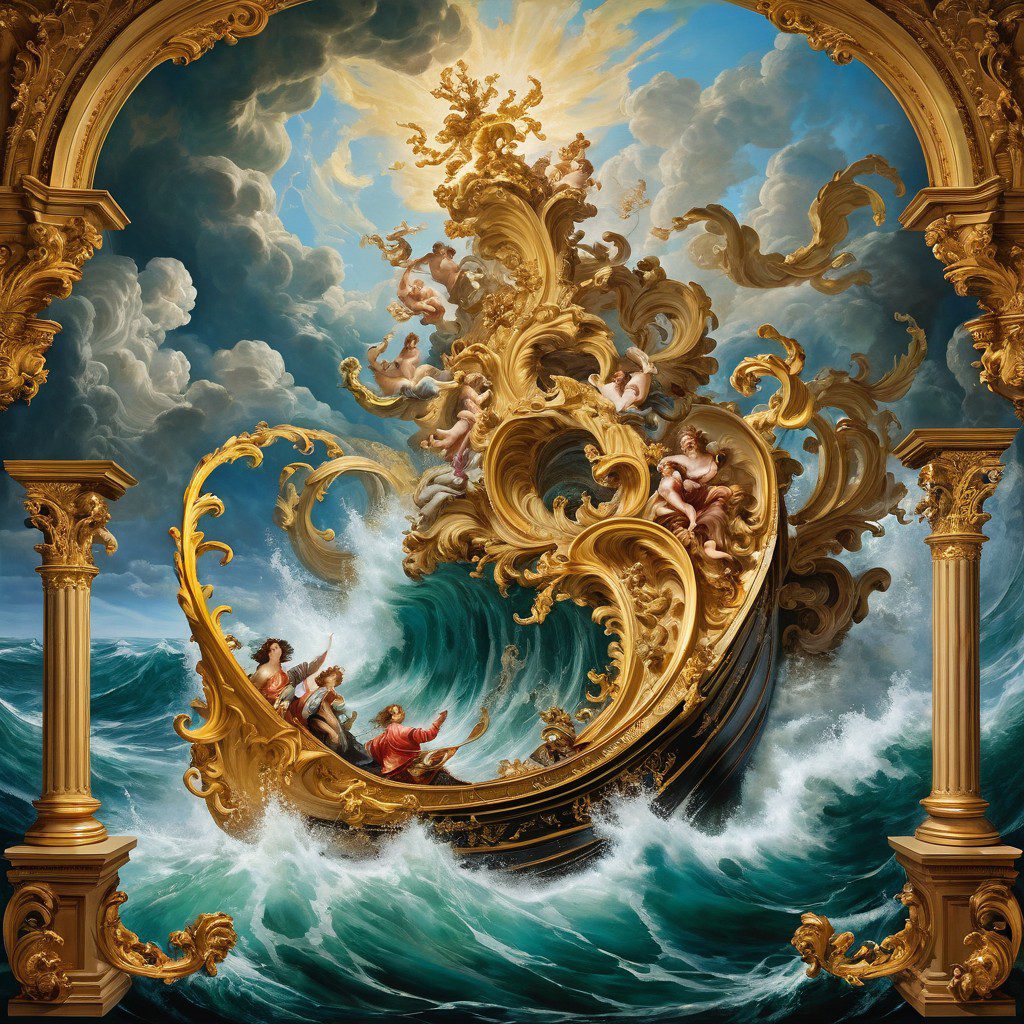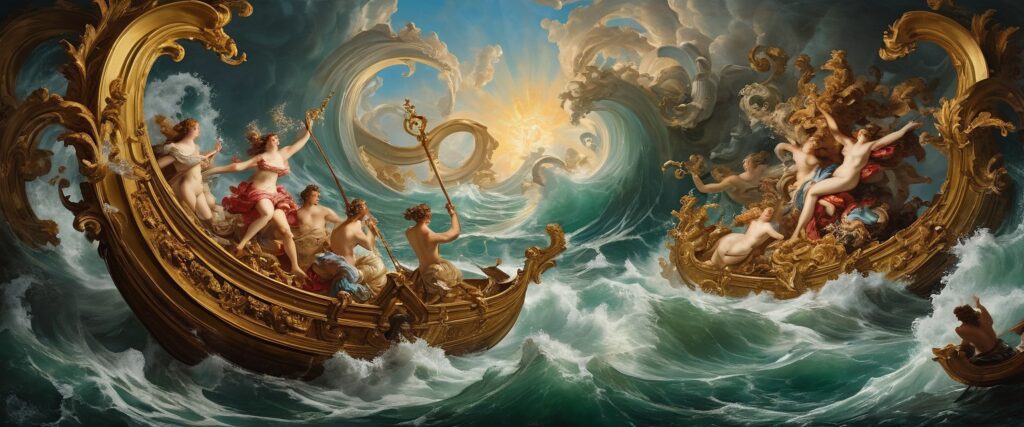Charybdis: The Devouring Maelstrom of Greek Myth

In the vast, perilous waters of ancient Greek mythology, few sea creatures strike as much fear into the hearts of sailors as Charybdis, the monstrous whirlpool that could consume entire ships. Paired with the equally dangerous Scylla, Charybdis embodied the unpredictable and destructive nature of the sea, a reminder of the dangers lurking in the natural world and, more symbolically, the consequences of excess and greed. Despite her relatively straightforward role in myth, Charybdis’s impact on the imaginations of storytellers—both ancient and modern—has been profound.
Origins and Mythological History
Charybdis’s myth begins with her lineage. According to most accounts, Charybdis was the daughter of the sea god Poseidon and the primordial earth goddess Gaia. Her creation story is often tied to her insatiable appetite and greed. Charybdis was known for her uncontrollable hunger, so much so that she even consumed vast portions of land and water to expand her father’s kingdom. This greed angered Zeus, the king of the gods, who struck her down with a lightning bolt, transforming her into a monstrous whirlpool as punishment.
In her new form, Charybdis lay at the bottom of the narrow strait between Italy and Sicily (the Strait of Messina, according to some interpretations), gulping down and belching out enormous amounts of water three times a day. This violent suction created a massive whirlpool capable of dragging ships to their doom, making Charybdis a symbol of the unpredictable and often deadly dangers of the sea.
The myth of Charybdis is most famously told in Homer’s Odyssey, where the hero Odysseus must navigate between Charybdis and her counterpart, Scylla, a six-headed monster who devours sailors. In this perilous passage, Odysseus chooses to sail closer to Scylla to avoid the more certain death of being swallowed by Charybdis. Later in his journey, when Odysseus’s ship is destroyed, he narrowly escapes death by clinging to a fig tree as his ship is sucked into Charybdis’s whirlpool, only to be spat back out later.
Symbolism of Charybdis
Charybdis represents several key themes in Greek mythology, many of which are deeply tied to humanity’s relationship with the sea. On one level, she is a clear embodiment of the perils of seafaring. For the Greeks, who were reliant on the sea for trade, warfare, and sustenance, the ocean was both a vital resource and a deadly threat. Charybdis captures this duality, reminding sailors that the sea can devour just as easily as it can provide.
But on a more symbolic level, Charybdis is often interpreted as a warning against excess. Her transformation from a goddess-like figure to a monstrous whirlpool is a direct result of her insatiable greed. In this way, Charybdis is not just a force of nature, but a metaphor for the dangers of unchecked appetite and consumption. Ancient myths were often moral lessons, and Charybdis’s story fits this mold perfectly.
Additionally, Charybdis represents the concept of being caught between two equally dangerous choices, a theme best captured by the phrase “between Scylla and Charybdis,” which refers to being trapped between two dangers where avoiding one means facing the other. This phrase continues to be used in modern contexts to describe difficult decisions, and it speaks to the deep cultural impact Charybdis’s myth has had over the centuries.
Charybdis in Literature and Modern Media

While Charybdis plays a supporting role in the mythology of Odysseus, her presence has endured in literature, film, and video games, evolving over time while retaining her core characteristics as a monstrous, inescapable force.
- Literature: In The Odyssey, Charybdis is described with intense drama and fear, emphasizing the peril she poses to any ship that ventures near her. Later works, such as Virgil’s Aeneid, also reference her as a warning to heroes who must brave the dangerous waters of the Mediterranean. The motif of Charybdis as a symbol of perilous waters would go on to inspire many nautical tales and legends throughout European literature, particularly during the age of exploration when dangerous whirlpools became associated with mythical sea monsters.
- Video Games: Charybdis appears in several video games, often as a formidable challenge or environmental hazard. In Assassin’s Creed Odyssey, players encounter both Scylla and Charybdis, reflecting the game’s deep engagement with Greek mythology. Similarly, in God of War, Charybdis is referenced as one of the deadly forces of the sea, though the character does not appear directly. Charybdis also appears in the Percy Jackson series, continuing her role as an obstacle for modern demigods in much the same way she did for Odysseus.
- Film and TV: While not as frequently portrayed on screen as other mythological creatures, Charybdis has made appearances in adaptations of The Odyssey, such as in the 1997 miniseries, where the whirlpool is brought to life with visual effects. Her portrayal typically emphasizes the same destructive, oceanic force she embodies in the original myth.
Strengths and Weaknesses of Charybdis
Strengths:
- Unstoppable Force of Nature: Charybdis is the personification of a powerful whirlpool, an inescapable and relentless force that can consume entire ships. Unlike many mythological monsters that can be fought or outwitted, Charybdis cannot be defeated—only avoided.
- Divine Origin: As a punishment from Zeus, Charybdis has divine backing. This makes her more than just a natural phenomenon; she is a god-inflicted punishment, untouchable by mortal powers.
- Symbol of Chaos: Charybdis embodies chaos and destruction, especially in the unpredictable and treacherous nature of the sea. This makes her a universal symbol of uncontrollable forces.
Weaknesses:
- Predictable Cycles: In most myths, Charybdis’s whirlpool is said to occur at regular intervals, which gives some sailors, like Odysseus, a slim chance of timing their passage to avoid her. This predictability, though dangerous, allows for some degree of planning and evasion.
- Lack of Agency: Unlike monsters like Scylla, who actively hunt sailors, Charybdis lacks agency. She is a force of nature, bound to her destructive pattern. This makes her less of an active predator and more of an environmental hazard.
- Bound to a Specific Location: Charybdis can only threaten those who sail near her location in the narrow strait. This limitation confines her danger to a specific area, whereas other mythological creatures can roam and hunt.
The Legacy of Charybdis
Charybdis, though not as anthropomorphized or as popular as other monsters from Greek mythology, remains a powerful symbol of nature’s unpredictable and destructive force. Her legacy endures in both the literal sense, as a terrifying whirlpool, and in the metaphorical, representing the consequences of greed, excess, and being caught between two dangerous options.
Modern adaptations of Charybdis, whether in literature, games, or film, continue to evoke that same sense of dread that ancient sailors must have felt when they imagined navigating the deadly waters between Scylla and Charybdis. Whether as a force of nature or a metaphor for difficult choices, Charybdis remains an enduring figure in the world of mythology and popular culture.
